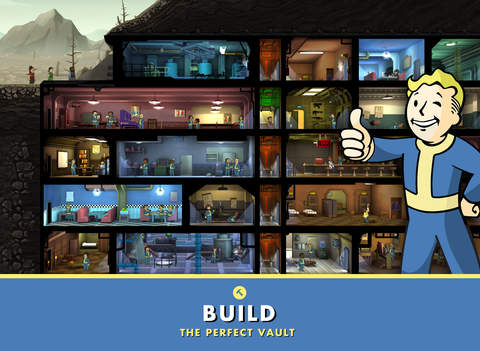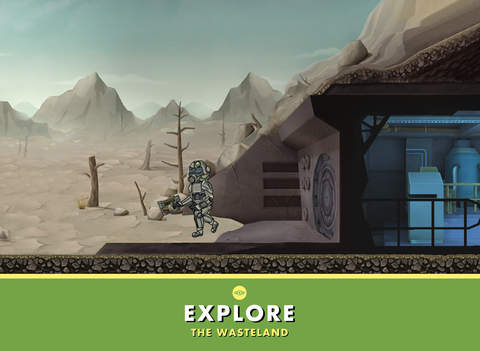It's up to you, Vault Boys and Girls.
Bethesda wowed the gaming world with the reveal of Fallout 4 at E3, and the anticipation has been growing ever since. To everyone's surprise, a companion game called Fallout Shelter has already been released on iOS (Android version to come soon) that both satiates every fan's desires for immediate Fallout goodness and also make us anticipate the next installment even more. This free-to-play title has already become the top downloaded IOS game in 48 countries, but its popularity seems to rely more on the strength of the IP than the actual quality of the game.
Fallout Shelter puts players in the almighty shoes of an invisible overseer whose main goal is to create an underground shelter, populate it with radiation-free inhabitants, and keep them safe. I love how the entire game is presented in the retro-futuristic '50s visual style of Vault-Tec advertising. All characters look similar to Vault Boy, as does their clothing, weaponry, and the underground rooms. This gives the game a very novel appearance and adds to the humor.
The underground adventure begins with a short line of survivors anxiously waiting to enter the vault, but they can't do so until the player first creates rooms to provide basic necessities. In order to survive, they need a living quarters, power plant, water treatment room, and a diner. One cool feature is how similar rooms placed next to each other will combine into a larger room if they're the same level (rooms can be upgraded). Larger rooms increase resource output, but I found that double rooms are the ideal size while anything larger drains too much power.
After the basic rooms are built, the player lets the survivors into the vault and assigns them to rooms. Every Fallout Shelter character (except for raiders) has SPECIAL stats just like those found in other Fallout games, and giving them a job in the appropriate room increases both the room's output and the survivor's happiness. This includes putting survivors with high agility ratings in the diner so they can attend to patrons quickly, and placing high-strength survivors in the power plant so they can turn the cranks and dials with ease. Only a few basic rooms are available to create at the beginning, with many more becoming unlocked as the population of the underground bunker grows.
Increasing the population is achieved by luring survivors to the bunker, finding them in lunchbox rewards (thanks to Vault-Tec magic), and by mating. Luring survivors can take a while and first requires a radio station, and finding them in lunchboxes is hit or miss, so mating is the easiest and most reliable method. It's actually kind of funny to place a male and female in the living quarters and watch their interaction. As long as they're not related, they will eventually retreat to a hidden room and create the beast with two backs. When they emerge, the female is visibly pregnant, and both can immediately return to work (maternity leave is so archaic!). Some time later, a baby is born and the rugrat walks around the bunker until they grow old enough to be put to work.
Playing this game is quite fun at first, and the micromanagement is more interesting than annoying. Unfortunately, it eventually becomes rather monotonous as there isn't much to do besides create more inhabitants, build more rooms, increase production, and get better gear. Speaking of which, there is a wide variety of clothing, armor, and weapons that come in handy. Clothing and armor have specific stat increases, and weapons are used to protect the vault from random raiders. Thankfully, there are a few distractions like equipping survivors with armor and weapons and sending them out into the wasteland to find valuable loot.
Sadly, players have absolutely no control over what happens to their adventurers and cannot control their combat or even see it. Instead, lines of text explain what happens to them in the wasteland, which can be funny, but it isn't satisfying. Another distraction is speeding up the production of rooms, which either results in immediate rewards or creates a fire that must be extinguished or a radroach infestation that must be quelled.
Nuka-Cola bottle caps are the main currency in this game, and they're used for building new rooms and upgrading them. Bottle caps are earned by rushing a room, completing objectives, exploring the wasteland, selling weapons and armor, and collecting production from a room. When some objectives are completed, players are rewarded with a lunchbox filled with four cards that each have random rewards such as bottle caps, armor, weapons, resources, and even survivors. Lunchbox rewards are few and far between when playing the game normally.

However, the micro-transaction aspect lets players buy lunchboxes for real money, and it's a true carrot-on-a-stick because it's fun to open lunchboxes and find random stuff. Sadly, I found that the best rewards came from purchased lunchboxes and not earned ones. For example, early in the game my characters were around level five, and I opened a purchased lunchbox to find a level 30 character. Another time early in the game I found a rocket launcher in a purchased lunchbox, which was much more powerful than my pistols and rifles. These rewards seem overpowered to me, especially so early in the game. Although this system isn't necessarily pay-to-win, it's definitely pay-to-gain-a-huge-advantage!
Don't get me wrong. I had fun playing Fallout Shelter, and it's a great way to get my Fallout fix while waiting for the next installment. I just feel like certain aspects of the game could have been fleshed out more and that it should be more complex. When I add the micro-transaction advantage to the post apocalyptic mix, the result puts a sour taste in my mouth, and it has nothing to do with radiation poisoning.
-
Authentic Vault Boy visuals
-
Being an overseer is empowering
-
Cool to see a different aspect of the Fallout series
-
Micro-transactions have too much advantage
-
Gameplay can get very slow and too basic
-
A bit wasted potential of the series











